Animals That Live In The Location Of The Great Gray Owl?


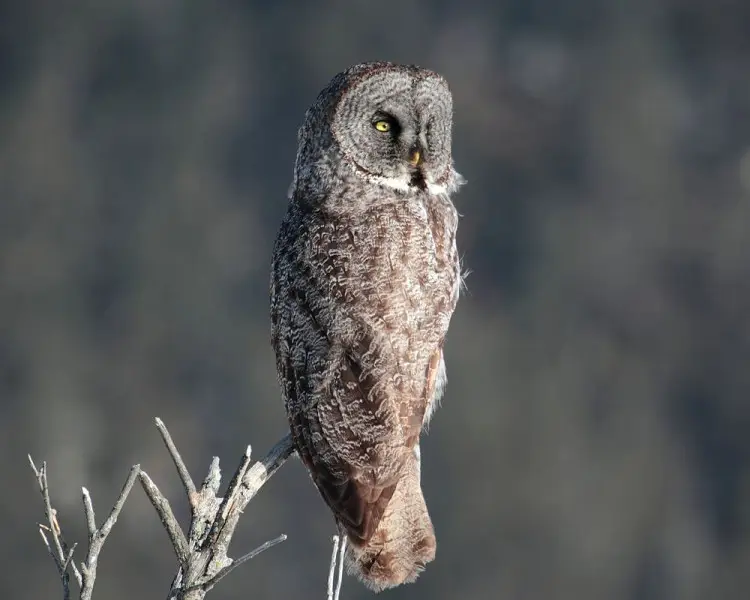
Great Greyness Owl
Slap-up gray owl, Phantom of the North, Cinereous owl, Spectral owl, Lapland owl, Spruce owl, Bearded owl, Sooty owl
Population size
50-100 k
The Swell grey owl is a very big owl, documented every bit the earth's largest species of owl past length. It is distributed across the Northern Hemisphere, and it is the only species in the genus Strix found in both the Eastern and Western Hemispheres. Adult Neat grey owls have a large rounded head with a greyness face and yellow eyes with darker circles effectually them. The underparts are light with dark streaks; the upper parts are gray with pale bars. These owls practise non accept ear tufts and take the largest facial disc of whatever raptor. There is a white collar or "bow necktie" just beneath the beak. The long tail tapers to a rounded end. The males are usually smaller than females, as with nearly owl species.
Photos with Great Grey Owl
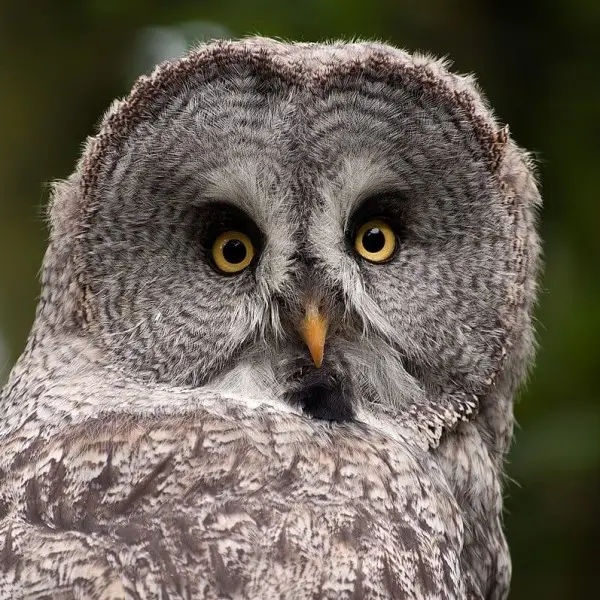
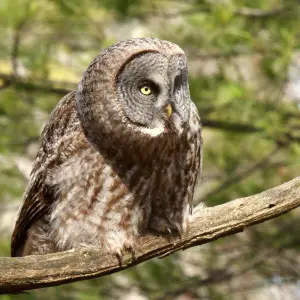
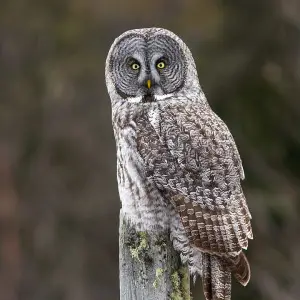
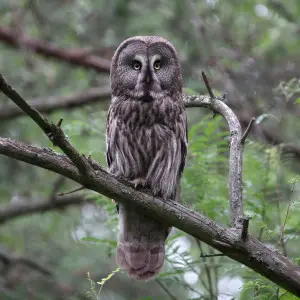
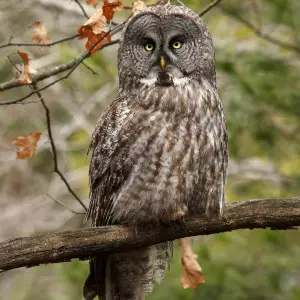
View 28 more photos of Not bad Grey Owl
Distribution
Geography
Republic of finland, Russian federation, Ukraine, Belarus, Cathay, Kazakhstan, Republic of lithuania, Mongolia, Kingdom of norway, Sweden, Show More United States, Canada, Deutschland, Poland Show Less
Great grey owls brood in North America from as far e every bit Quebec to the Pacific coast and Alaska, and from Finland and Estonia across northern Asia. They are permanent residents, although northerly populations may move south and southeast when food is scarce. In Europe, they are institute breeding in Norway and Sweden and more numerously through Republic of finland and Russia. In northern areas, Dandy grey owls prefer to brood in the dense coniferous forests of the taiga, near open areas, such as meadows or bogs. In Oregon and California, they may nest in mixed oak woodlands.
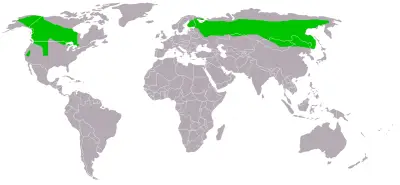
Biome
Climate zones

Habits and Lifestyle
Great grey owls are mostly solitary birds and outside of the breeding season adopt to spend their fourth dimension singly. They are very powerful hunters that wait, listen, and sentry for prey, then dive down; they also may fly depression through open areas in search of prey. They often hunt from a low listening mail which tin be a stump, low tree limb, fence post, or road sign. Their big facial disks, too known as "ruffs", focus sound, and the asymmetrical placement of their ears assists them in locating prey, considering of the lack of lite during the belatedly and early hours in which they hunt. On the nesting grounds, Great grey owls mainly chase at night and most dawn and dusk; at other times, they are agile generally during the nighttime. Great grey owls are not as aggressive as most other alpha predators. They are less probable to assault each other or potential threats than are other large predatory birds. They practise not protect a large nesting territory, nor do they defend hunting territories through aggression. As an exception, the female person is aggressive in protecting eggs and owlets. She is especially alert and ambitious when fledglings showtime leave the nest but cannot withal wing, and thus are extremely vulnerable. Great greyness owls communicate with a series of very deep, rhythmic 'whoos', which are usually given in correlation to their territories or in interactions with their owlets. At other times, adults are commonly silent. The young may churr, shriek, or hiss.
Diet and Nutrition
Dandy gray owls are carnivores and rely well-nigh fully upon small rodents. What species they eat depends on which small-scale mammals are near arable and available. These include lemmings, pocket gophers, voles, hares, moles, shrews, weasels, thrushes, grouse, Canada jays, mountain quail, modest hawks, and ducks.
Mating Habits
Peachy grey owls are monogamous and form pairs. Nesting usually occurs from March to May. They exercise non build nests, so they typically use nests previously used by a large bird, such equally a raptor. They volition also nest in broken-topped trees and cavities in large trees. The female typically lays four eggs and incubates them from 28 to 36 days. Owlets hatch blind and helpless. Brooding lasts 2 to 3 weeks, after which the female starts roosting on a tree near nests. The young jump or fall from the nest at 3 to 4 weeks, and start to wing i to two weeks later this. Immediately after fledging, the white, fuzzy owlets must use beaks and feet to climb back into trees. The female is on baby-sit at this time and may exist aggressive toward potential predators. Most owlets remain near their natal sites for many months after fledging. Normally the male person hunts for his mate and the young throughout the nesting menses. Once the owlets begin the fly, the female typically withdraws and the male continues to feed the young until they tin can hunt on their ain in the autumn. The young owls go off on their ain past winter.
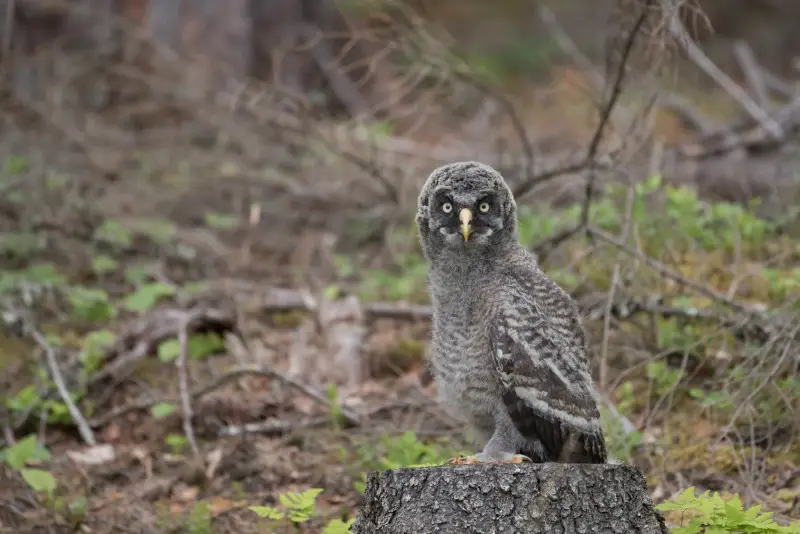
Population
Population threats
The harvest of timber from the Peachy grey owl's habitat is, perhaps, the greatest threat to this species. Intensified timber management typically reduces alive and dead big-diameter copse used for nesting, leaning trees used by juveniles for roosting before they tin wing, and dumbo canopy closures in stands used past juveniles for embrace and protection. If perches are not left in articulate-cuts, Bully grey owls cannot readily chase in them. Although human-fabricated structures (made specifically for employ past this species) have been utilized past these owls, the species is far more than common in areas protected from logging. Livestock grazing in meadows also adversely affects Great greyness owls, by reducing habitat for preferred casualty species. Other dangers to these birds include rodenticides, and collisions with vehicles.
Population number
According to the IUCN Red Listing, the total population size of the Great grey owl is 50,000-99,999 mature individuals. Currently, this species is classified equally Least Concern (LC) on the IUCN Red List and its numbers today are increasing.
Fun Facts for Kids
- Great greyness owls have first-class hearing and may locate (and so capture) prey moving below 60 cm (ii.0 ft) of snowfall in a series of tunnels solely with that sense. They then can crash to a snow depth roughly equal to their ain body size to grab their prey. Only this species and, more infrequently, other adequately large owls from the genus Strix are known to "snow-plunge" for casualty, a addiction that is thought to require superb hearing not possessed by all types of owls.
- Due to the lack of territorial aggressiveness Great gray owls are difficult to find in the field. Nearly owls respond to their own species' calls if played back in a nesting territory. Great grey owls will often ignore such calls. They too exercise not flush every time human approaches or drives by. Not bad greyness owls oft remain however even if a human is nearby and therefore they are often overlooked or unnoticed.
- Due to their big size, Keen grey owls have few natural predators. They are even able to fend off animals as large as Black bears when defending their nests!
References
More Fascinating Animals to Learn About
Source: https://animalia.bio/great-grey-owl
Posted by: kempclumse.blogspot.com

0 Response to "Animals That Live In The Location Of The Great Gray Owl?"
Post a Comment